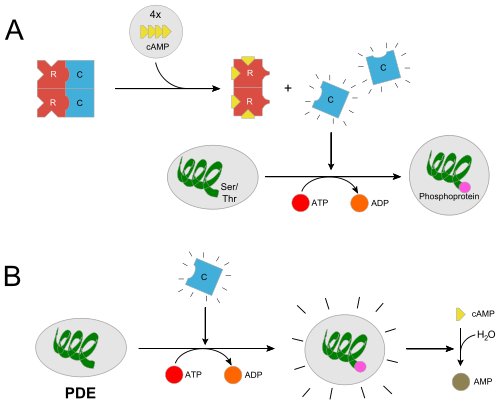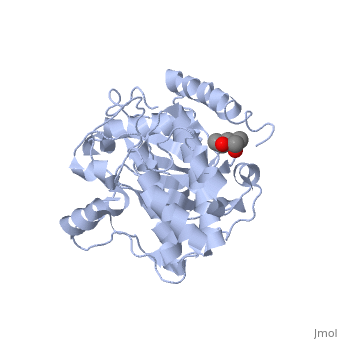CAMP Dependent Protein Kinase, Catalytic Subunit
From Proteopedia
IntroductionThe catalytic subunit of PKA is model kinase that is very well characterized because of its catalytic and structural simplicity and ease of Isolation. PKA is essential to cellular signalling in eukaryotes and is involved in a myriad of different processes depending on cell type. PKA catalyzes the transfer of a gamma-phosphoryl group of a molecule of ATP to either a serine or threonine residue on the target protein. This post-translational modification can serve to alter the function of the phosphorylated target protein. General Domain StructureThe catallytic subunit of PKA consists of a bilobal kinase fold that is characteristic of many kinases throughout nature. The upper N-terminal lobe of the kinase is dominated by beta-sheet architecture while the lower, larger C-term is mostly alpha helical. Located in between the two lobes is the catalytic cleft. [1] The N-terminus of the catalytic subunit is myristylated, although this is not shown in the electron density of this crystal structure. The myristylation does not confer membrane localization but stabilizes the enzyme to denaturation by a factor of 5. [2] Activation and Interaction with Regulatory SubunitIn the inactive state, the catalytic subunit of PKA exists as a heterotetramer with two regulatory subunits and two catalytic subunits. Regulatory subunits often interact with A Kinase Anchoring proteins that serve to localize a population of PKA in a certain cellular environment, priming a particular response. Upon, cAMP binding to the regulatory domain of PKA (two molecules of cAMP per regulatory subunit) the catalytic subunit is released from the holoenzyme complex and is free to diffuse and exhibit its catalytic activity. Two of the most important residues for this docking interaction are Trp196 and Tyr247 which both sit in the nucleotide binding region (Phosphate Binding Cassette) of the regulatory subunit. In essence, when a cAMP molecule binds to these trp and tyr binding sites, the docking interaction is ablated. This scene shows a different representation. [3] [4]
Binding to ATPTypical kinases are characterized by 3 highly conserved glycine residues located near the junction between the small and large kinase subunits. The loop region that these occur in is referred to as the glycine-rich loop. Mutation of any of these residues results in dramatic reduction of kinase affinity for ATP. The structural motif that the glycine rich loop is located in is a beta-strand, turn, beta-strand motif. These residues are also reported to have some role in phosphoryl transfer. [5] Interaction with SubstrateThe larger C-terminal lobe of the kinase is responsible for substrate recognition. Several of the c-term lobes alpha helices are important in determining substrate recognition. The substrate mimic inhibitor PKI demonstrates this nicely. The PKI inhibitor is a heat shock protein. It sits firmly within the catalytic cleft of the enzyme. [6] |
| |||||||||||
3D structures of CAMP-dependent protein kinase
References
- ↑ Taylor SS, Radzio-Andzelm E, Knighton DR, Ten Eyck LF, Sowadski JM, Herberg FW, Yonemoto W, Zheng J. Crystal structures of the catalytic subunit of cAMP-dependent protein kinase reveal general features of the protein kinase family. Receptor. 1993 Fall;3(3):165-72. PMID:8167567
- ↑ Yonemoto W, McGlone ML, Taylor SS. N-myristylation of the catalytic subunit of cAMP-dependent protein kinase conveys structural stability. J Biol Chem. 1993 Feb 5;268(4):2348-52. PMID:8428909
- ↑ Kim C, Cheng CY, Saldanha SA, Taylor SS. PKA-I holoenzyme structure reveals a mechanism for cAMP-dependent activation. Cell. 2007 Sep 21;130(6):1032-43. PMID:17889648 doi:10.1016/j.cell.2007.07.018
- ↑ First EA, Bubis J, Taylor SS. Subunit interaction sites between the regulatory and catalytic subunits of cAMP-dependent protein kinase. Identification of a specific interchain disulfide bond. J Biol Chem. 1988 Apr 15;263(11):5176-82. PMID:3356685
- ↑ Hemmer W, McGlone M, Tsigelny I, Taylor SS. Role of the glycine triad in the ATP-binding site of cAMP-dependent protein kinase. J Biol Chem. 1997 Jul 4;272(27):16946-54. PMID:9202006
- ↑ Zheng J, Knighton DR, ten Eyck LF, Karlsson R, Xuong N, Taylor SS, Sowadski JM. Crystal structure of the catalytic subunit of cAMP-dependent protein kinase complexed with MgATP and peptide inhibitor. Biochemistry. 1993 Mar 9;32(9):2154-61. PMID:8443157



